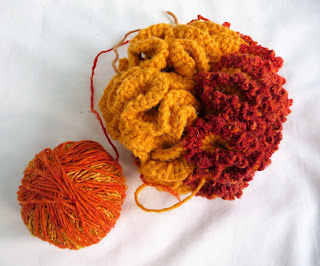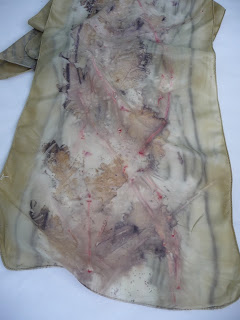SPINOPOLY. In case you were wondering, this game is an adaptation of Monopoly, played backstage by a troupe of singing, dancing sheep, collectively known as the Blewe Belles.
At Christmas, my companion, Elinor Gotland, sent me a ticket for the opening night of their latest musical, 'Shepherdesses' Watch'. Since she herself would be starring in it, I sat alone in the stalls, rigid with nervous anticipation as the curtain went up. Act One opened with The Flock Sock Knit and Natter. Elinor descended from the clouds on the proscenium arch and within minutes, it was clear the show was going to be an absolute triumph.
There were roars of applause and a standing ovation for Elinor's first number, 'Thank Heaven for Knits and Purls.' The Blewe Belles sang backing vocals whilst tap dancing, twirling their knitting needles in band majorette style. By the end of the routine, those socks had disappeared, leaving the stage encircled by a woven braid of coloured yarn.
For me, the highlight of the show was 'Baa-baa, Barn Barbeque' sung accapella. Afterwards, I rushed round to the Stage Door to congratulate them all. Struggled my way through the crowds of autograph hunters, flashing my backstage pass at the doorman, only to find Elinor's dressing room empty. Bleats and shrieks were coming from the room next door and there she was, in amongst the Blewe Belles, slinging her wings over the back of a chair, just as SPINOPOLY came out of its box.
"Right, I'll be the Wool Marketing Board this time. Hiya, Fran, enjoyed the show, did you?" Elinor barely glanced up from doling out the money. "Have a seat, Beaut, I'll deal you in."
The familiar London street names had all been changed for fibres of varying price and quality, from Herdwick Lane to Cashmere Avenue via Blue Faced Leicester Square. After the first few rounds, all the properties had been sold and I found myself not with four stations, but four Wool Fairs, for which I could only charge admission. The others got busy buying up sheep tokens for each parcel of land they owned and it was not long before I was bankrupted - landing on Gotland Gardens with a whole flock grazing. No surprise to find this was owned by Elinor.
The Blewe Belles put up some stiff opposition. Elinor got stuck in the Sheep Dip, then she was landed with vet's bills and for a while, luck seemed to be running their way.
However, it proved to be a game of two halves. After a series of chance set backs for the other players, Elinor's ruthlessly competitive attitude secured her the final victory and total domination of the fibre supply.
They might have lost the game, but none of the Blewe Belles had wasted their time. Getting up from the table, I noticed all that yarn had been knitted back into socks, ready for tomorrow night's show. To a chorus of goodbyes and hugs from everyone, I hurtled out of the theatre into the cold city streets with barely enough time to catch the last train back to Wales.
A most memorable evening's entertainment. I'm shattered now, though and will be more than content to see the New Year in at home - just possibly, playing SPINOPOLY.
At Christmas, my companion, Elinor Gotland, sent me a ticket for the opening night of their latest musical, 'Shepherdesses' Watch'. Since she herself would be starring in it, I sat alone in the stalls, rigid with nervous anticipation as the curtain went up. Act One opened with The Flock Sock Knit and Natter. Elinor descended from the clouds on the proscenium arch and within minutes, it was clear the show was going to be an absolute triumph.
There were roars of applause and a standing ovation for Elinor's first number, 'Thank Heaven for Knits and Purls.' The Blewe Belles sang backing vocals whilst tap dancing, twirling their knitting needles in band majorette style. By the end of the routine, those socks had disappeared, leaving the stage encircled by a woven braid of coloured yarn.
For me, the highlight of the show was 'Baa-baa, Barn Barbeque' sung accapella. Afterwards, I rushed round to the Stage Door to congratulate them all. Struggled my way through the crowds of autograph hunters, flashing my backstage pass at the doorman, only to find Elinor's dressing room empty. Bleats and shrieks were coming from the room next door and there she was, in amongst the Blewe Belles, slinging her wings over the back of a chair, just as SPINOPOLY came out of its box.
"Right, I'll be the Wool Marketing Board this time. Hiya, Fran, enjoyed the show, did you?" Elinor barely glanced up from doling out the money. "Have a seat, Beaut, I'll deal you in."
The familiar London street names had all been changed for fibres of varying price and quality, from Herdwick Lane to Cashmere Avenue via Blue Faced Leicester Square. After the first few rounds, all the properties had been sold and I found myself not with four stations, but four Wool Fairs, for which I could only charge admission. The others got busy buying up sheep tokens for each parcel of land they owned and it was not long before I was bankrupted - landing on Gotland Gardens with a whole flock grazing. No surprise to find this was owned by Elinor.
The Blewe Belles put up some stiff opposition. Elinor got stuck in the Sheep Dip, then she was landed with vet's bills and for a while, luck seemed to be running their way.
However, it proved to be a game of two halves. After a series of chance set backs for the other players, Elinor's ruthlessly competitive attitude secured her the final victory and total domination of the fibre supply.
They might have lost the game, but none of the Blewe Belles had wasted their time. Getting up from the table, I noticed all that yarn had been knitted back into socks, ready for tomorrow night's show. To a chorus of goodbyes and hugs from everyone, I hurtled out of the theatre into the cold city streets with barely enough time to catch the last train back to Wales.
A most memorable evening's entertainment. I'm shattered now, though and will be more than content to see the New Year in at home - just possibly, playing SPINOPOLY.





















































